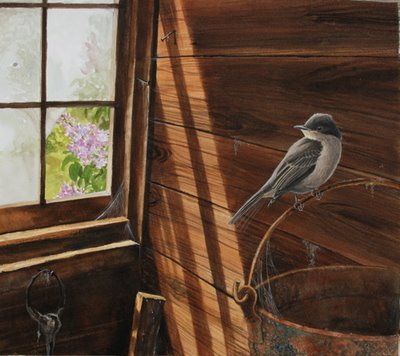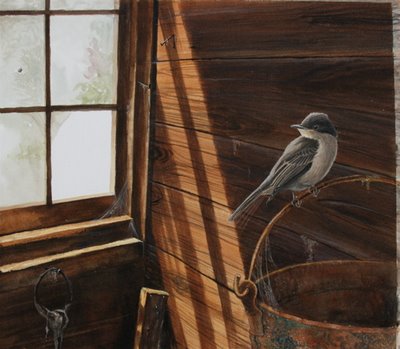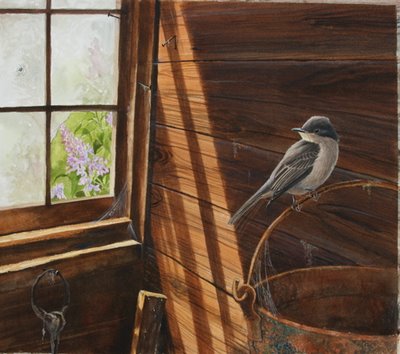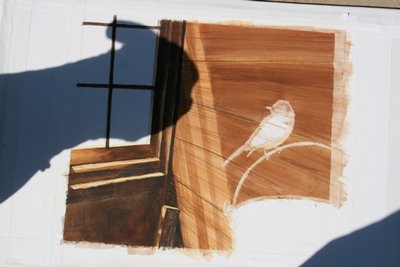Painting a Phoebe-Finis

All right. The wood's under control. Finally, I am ready to tackle the window view. I wanted a light, springy scene out there, and the best evocation of that-and of the antiquity of the scene-was a lilac. Better than that, the heirloom lilac from Bill's family farm. (The one that's all frozen crispy right now, all 50-plus blossom trusses pointing at the ground). I wanted the outside view to be flooded with light, in contrast to the barn interior. So I had to keep the hazy window glass quite light and bright, so it would be a believable source of the strong light flooding the room.
I love the idea of a single spot of riotous color in an otherwise three-color painting. I took the mockup pane off, enjoying the look of the painting before the real lilac went in. It could be a snowy day now, but for the ghost of a lilac in the middle right pane.

Before "dessert," I went back to further darken the bird, so it could believably sit in the dark barn interior. It was fun to play with the bird's colors, darkening and strengthening them, and yet still making the bird's underparts read as grayish white. On the painting, they're a medium brownish-purple!) I did this by darkening its upperparts accordingly. It is the contrast between upper and underparts that fools the eye into reading it as a gray and white bird.
Darker, darker, darker. Drama, drama, drama. I kept taking washes of ultramarine blue and a little Chinese white over the boards, which was a tricky thing to do now that the bird was in. Still needed to age those boards. The crud really helped, I think.
Almost shivering with anticipation, I readied myself to paint the lilac bit. In some ways, the lilacs are the most important part of the painting, more important than the bird, because they evoke the world outside, the possibility of the phoebe's life, in freedom outside the nesting barn. I don't want the lilacs to be photographic. I want them to be dreamy and drenched in sun.
So I paint fast and resist the temptation to get all carried away with detail.
I think it's done now. I'm calling it "The Missing Pane." Decrepitude is in the eye of the beholder. For phoebes, for barn owls, barn swallows, house and Carolina wrens, mice, snakes, bats, for me and many others, decrepitude's an open door, an invitation.
 If you've enjoyed following the process of "The Missing Pane's" creation, and would like a memento for your wall, you can order a print of the painting with this link. There will be a limited edition of 300, and I'll sign each one (and inscribe it to someone special if you wish). Prints should be ready by late June. You can pre-order and get it before anyone else. The painting will appear on the cover of Bird Watcher's Digest's July/August 2007 issue, with an article about raising Avis and Luther, the orphaned phoebe babies, inside. See the June and July 2006 archives for the whole story. Phew. That's about as many links as you want in one paragraph, huh?
If you've enjoyed following the process of "The Missing Pane's" creation, and would like a memento for your wall, you can order a print of the painting with this link. There will be a limited edition of 300, and I'll sign each one (and inscribe it to someone special if you wish). Prints should be ready by late June. You can pre-order and get it before anyone else. The painting will appear on the cover of Bird Watcher's Digest's July/August 2007 issue, with an article about raising Avis and Luther, the orphaned phoebe babies, inside. See the June and July 2006 archives for the whole story. Phew. That's about as many links as you want in one paragraph, huh? I would like to thank my studio assistant, Chet Baker. He kept me company, kept the kisses coming for a lonely painter, and only occasionally rui--ahem, enhanced-- a shot. He's convinced that any time a camera's out, he's going to be the subject. And thanks to you, for being here with me, and for all your nice comments and encouragement. I've never painted with an audience before. It's fun!
I would like to thank my studio assistant, Chet Baker. He kept me company, kept the kisses coming for a lonely painter, and only occasionally rui--ahem, enhanced-- a shot. He's convinced that any time a camera's out, he's going to be the subject. And thanks to you, for being here with me, and for all your nice comments and encouragement. I've never painted with an audience before. It's fun!Labels: limited-edition print, step by step, Watercolor painting






<< Home